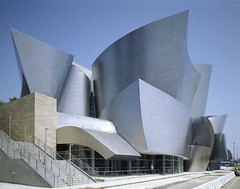A different take on DC's plan for an architectural icon baseball stadium
 Iconic Architecture. Walt Disney Concert Hall. Designed by Frank Gehry. Courtesy of the Los Angeles Philharmonic. Photocredit: Tom Bonner
Iconic Architecture. Walt Disney Concert Hall. Designed by Frank Gehry. Courtesy of the Los Angeles Philharmonic. Photocredit: Tom BonnerFrom City Journal--
Take Me Out to the Ballpark
Steven Malanga
Today’s new baseball stadiums offer a lesson in smart urbanism.
When Jacob Ruppert and Tillinghast Huston built Yankee Stadium in the early 1920s (on land acquired from the Astor family), colleges across the country were erecting huge sports palaces like the Yale Bowl. Taking the bigger-is-better trend a step further, Yankee Stadium was much larger than many of the major-league parks that then existed, representing the owners’ bet that the Yankees’ popularity would soon explode, thanks to the exploits of a guy named Ruth.
George Steinbrenner’s plan to build a new Yankee Stadium is part of a new and different kind of sports-building boom. What everybody calls “ballparks”—intimate, charming fields, with flourishes of historical design that fans love—are springing up everywhere, and New York will soon join the fun with a Yankee Stadium that incorporates some features of the original, but in a cozier, viewer-friendlier setting. It’s too bad that office-tower developers (and the firms that rent space in the offices) haven’t followed suit with people-centric buildings. The builders continue to uglify American cities with soulless modern office monstrosities; Daniel Libeskind’s inhuman glass Freedom Tower for the World Trade Center site, even as modified by architect David Childs, would be only the latest example.
Sports team owners hardly seem the types to lead an urban design revolution. But they’ve learned a marketplace lesson. Back in the 1960s and seventies, they built a raft of stadiums that mirrored the bleak aridity of modern office buildings: multi-use facilities, laid with artificial turf and surrounded by vast concrete parking lots—ugly and fan-unfriendly. The era of such stadiums ended with the opening of the Chicago White Sox’s New Comiskey Park in 1991. After a brief spike, White Sox attendance soon fell below its level at old Comiskey. Baseball fans derided the new park, renamed U.S. Cellular Field in 2003, as a “mallpark.”
The current era of traditionalist stadiums began in 1992, with Oriole Park at Camden Yards in Baltimore.
Tellingly, the idea for the park came up after the team’s former owner noticed that the franchises with the healthiest fan draws—the Yankees, the Boston Red Sox, and the Chicago Cubs—all played in old stadiums with idiosyncratic, traditional features. Oriole Park sought to capture the old-time magic with a retro-style design, opting for an arched brick facade instead of the concrete supports typical of modern stadiums, an asymmetrical playing field, and extravagant details like a giant clock looming over the scoreboard. The park was an instant hit. Only once has Oriole home attendance dipped below where it was the final year in their old stadium, even though the team has struggled. Since 1992, other teams have also served up retro ballparks, including the San Francisco Giants (SBC Park) and the Pittsburgh Pirates (PNC Park)—and, prospectively, the New York Mets.
Predictably, the modernist- and postmodernist-dominated architectural establishment hates the new stadiums. Former New York Times architecture critic Herbert Muschamp, for instance, dubs them “America’s most diseased building type,” rising out of baseball’s “sickly longings for a past that never existed, a pastoral, even anti-urban, vision.”
In fact, the new parks are anything but anti-urban. One of their key appeals is how they respectfully integrate with the urban landscapes around them. San Diego’s Petco Park, an exemplar of the new-old style, for instance, incorporates elements of the local Spanish-mission style, including a lovely sandstone and tan stucco exterior. Similarly, designers finished off the facade of Pittsburgh’s PNC Park in rough limestone to match its setting in a former industrial area.
By contrast, the modernists largely ignore the idea of architectural context, believing that it shackles their imaginations. It’s a shame that developers and business executives have caved under elite pressure and erected and occupied so many alienating modernist office buildings. It’s rare to find a developer who’ll actually live in a home built in this arid style. And it’s worth noting that CEO offices in today’s Corbusian towers often boast wood paneling and other warm features sharply at odds with the cold environments encasing them. Yet the modernist eyesores keep going up, perhaps because those who commission them don’t want to look behind the times.
Thankfully, baseball owners, Steinbrenner among them, don’t seem to care about such things. Plus, they need to please fans, who want nothing to do with Corbusian ballparks and believe instead that we should build upon the past, not brusquely discard it.
_______________
Also see, "Tale of Two (or more) Cities."



0 Comments:
Post a Comment
<< Home